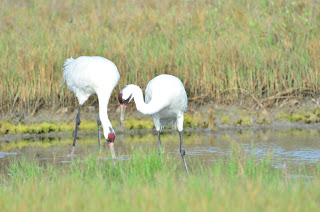I stood on the bow holding my breath and trying not to move. My binoculars and the telephoto lens my friend lent me were not necessary. For a brief moment, I thought the whooping crane wading in the marsh less than ten yards away would step onto the boat and join our small party of birders. Instead, a blue crab caught the crane’s attention and we had the opportunity to watch it pound the crustacean into submission before swallowing it whole. Its mate was feeding about twenty-five yards away. Both cranes were unconcerned by our presence and after our initial excitement, the camera lens starting clicking.
 |
| Photo by photographer Mike Sloat |
It was just after sunrise rise. I was with two photographer friends on the Aransas National Wildlife Refuge. Captain Kevin Sims had maneuvered us into the marshes of the only wild whooping crane wintering habitat in the world. I had taken several other boating tours into the bay, but the boats were too big to motor through the shallower parts of the refuge.
Aboard Kevin’s double-decker customized boat, birders, photographers, and nature enthusiasts have the rare opportunity to view birds not often seen from land.
Aboard Kevin’s double-decker customized boat, birders, photographers, and nature enthusiasts have the rare opportunity to view birds not often seen from land.
After my last trip, I asked Kevin a few questions about his business, Aransas Bay Birding Charters. http://www.texasbirdingcentral.com/
Kathleen: How long have you been in business and what got you started?
Kevin: We have been in business for ten years now. We got started on a whim. I was maintaining the boat for the previous owner he was interested in retiring so when he wanted to sell I bought the business and took over.
Kathleen: What do you enjoy the most about conducting birding tours?
Kevin: I enjoy showing people the Whooping Cranes and other birds. It is fun to share my experiences with them especially if they are from land locked locales.
Kathleen: Do you operate all year long, if so, what are your busiest months?
Kevin: We operate from mid-October through mid-May and sometimes into the first of June. January through April are our busiest months since the migratory birds are on the refuge and the rookery is alive with nesting.
Kathleen: What type of people take your tour? How does it differ from others in the area?
Kevin: Our trip is different from the others in several ways. We cater to the photographer. We will stay on one subject as long as they want. We only take out small groups, no more than six people. We are on the customers schedule instead of him being on our schedule. We only run one trip a day so that we will not have to rush a customer back to the dock to take out someone else. The boat is custom made with photography in mind. Ninety-eight percent of my customers are professional or serious amateur photographers. I do get the occasional family with small children and birders who do not wish to take a group tour boat.
Kathleen: Besides the whooping crane, what birds are tourists most interested in seeing?
Kevin: Everyone is interested in the Whooping Crane but they also want to see anything they haven’t seen in the past. Most want Roseate spoonbills and anything that is unique such as white morph reddish egrets and white morph blue herons. Photographers are happy with anything that is different. Mostly they are happy with anything they can get a picture of. Oyster Catcher and Black Skimmers are always popular. Reddish Egrets are often requested as well.
Next time you’re planning a birding trip on the Texas Coast, check out Kevin Sims’ Aransas Bay Birding Charpters for an intimate encounter with North America’s most endangered bird.


